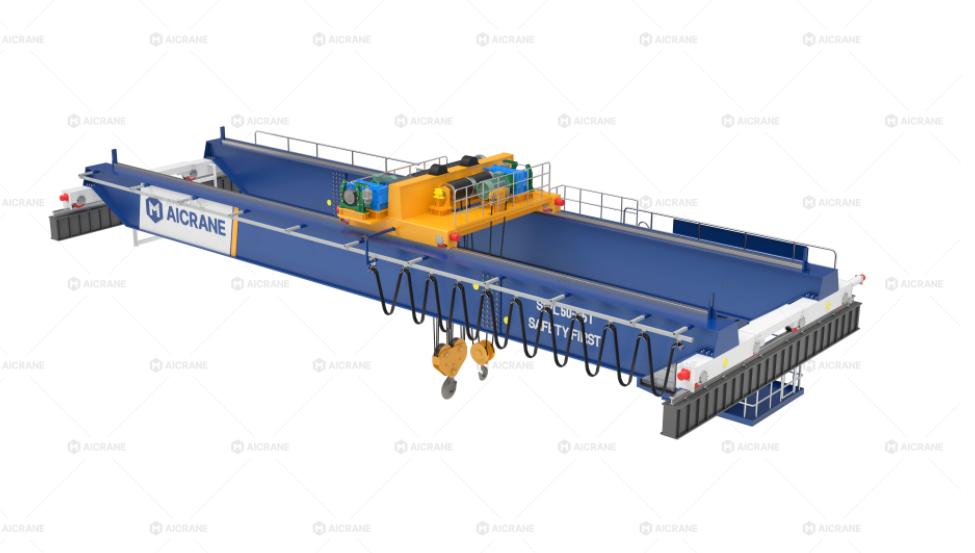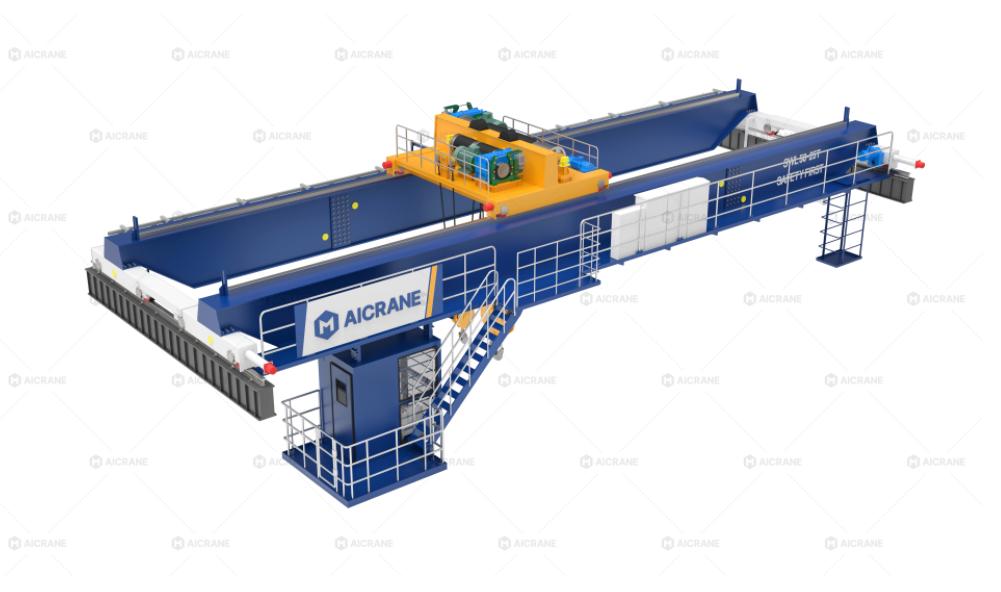Modern Control Systems for 50 Ton Overhead Crane Design
Overhead cranes play a central role in heavy lifting operations across industries such as steel manufacturing, shipbuilding, automotive, and power generation. Among them, the 50-ton overhead crane is a versatile and widely used type, capable of handling substantial loads with precision and safety. While the mechanical and structural design ensures the crane’s strength and durability, modern control systems are what truly define its performance, efficiency, and reliability.
This article explores the role of modern control systems in 50-ton overhead crane design, highlighting their functions, components, benefits, and impact on safety and productivity.

The Evolution of Overhead Crane Controls
Traditionally, overhead cranes were operated with basic wired pendant controls. Operators had limited visibility and maneuverability, making load handling less efficient and sometimes risky. Over time, the industry has shifted toward advanced electronic and digital controls that enhance accuracy, responsiveness, and operator convenience.
Today, modern control systems combine hardware (motors, inverters, sensors) with software (automation logic, monitoring, and diagnostics). For a 50 ton overhead crane, such systems ensure smooth and safe operations even under demanding conditions, while meeting international safety and efficiency standards.
Core Components of Modern Control Systems
The control system in a 50-ton overhead crane is a complex integration of several technologies. Below are the key components:
1. Variable Frequency Drives (VFDs)
- VFDs control the speed of motors by adjusting frequency and voltage.
- They provide smooth acceleration and deceleration, reducing mechanical stress on the crane.
- VFDs also allow for precise positioning of heavy loads, essential when handling valuable or delicate materials.
2. Programmable Logic Controllers (PLCs)
- PLCs act as the brain of the crane’s automation system.
- They execute commands from the operator, coordinate movements, and ensure safe operation by monitoring inputs from sensors.
- PLCs also allow customization of lifting sequences, anti-collision systems, and interlocks for specific applications.
3. Human-Machine Interfaces (HMIs)
- Touchscreen panels or display units provide operators with real-time information on load weight, position, and system status.
- HMIs also show diagnostic data and alerts, simplifying troubleshooting and maintenance.
4. Remote Control Systems
- Wireless remote controls give operators freedom of movement, enabling better visibility of the load and working area.
- Modern systems use secure radio frequency communication with fail-safe mechanisms to prevent accidental commands.
- Dual-joystick remotes allow simultaneous control of multiple motions.
5. Safety Sensors and Monitoring
- Load cells measure the actual load being lifted, preventing overload situations.
- Anti-sway sensors minimize load swinging by adjusting motor speeds dynamically.
- Proximity and anti-collision sensors protect against accidents in multi-crane environments.
6. Data Logging and IoT Integration
- Advanced cranes include IoT-enabled systems that track usage patterns, load cycles, and component health.
- Data is stored in cloud platforms or local servers for predictive maintenance and performance analysis.

Advanced Features in 50 Ton Crane Control Systems
Modern overhead crane control systems are not just about moving heavy objects; they bring intelligence, efficiency, and safety to operations. Here are some advanced features commonly integrated:
1. Anti-Sway Technology
- By detecting and compensating for load swing, anti-sway control ensures precise load placement.
- This feature reduces downtime and improves workplace safety, particularly in confined spaces.
2. Automatic Positioning
- Operators can set predefined paths or positions.
- The crane then moves automatically to the designated location with minimal operator intervention.
- This is useful in repetitive tasks like warehouse operations or assembly lines.
3. Zone Protection and Collision Avoidance
- Virtual “no-go zones” can be programmed to keep the crane from entering restricted areas.
- Collision avoidance systems stop or slow the crane if another crane or obstacle is detected nearby.
4. Load Weighing and Monitoring
- Real-time load weighing prevents accidental overloading.
- Operators can access load history, improving accountability and safety compliance.
5. Energy Efficiency Features
- Regenerative drives convert braking energy into reusable electrical energy, reducing operating costs.
- Energy monitoring allows companies to optimize crane usage for efficiency.
6. Remote Diagnostics and Maintenance
- Technicians can access crane data remotely to diagnose issues, reducing downtime.
- Predictive maintenance alerts notify operators before components fail.
Benefits of Modern Control Systems for 50 Ton Overhead Cranes
The adoption of modern control systems offers significant advantages:
1. Enhanced Safety
- Real-time monitoring and automated safety features drastically reduce the likelihood of accidents.
- Overload protection, anti-sway, and zone protection protect both operators and equipment.
2. Greater Precision
- Smooth motor control and advanced positioning systems enable accurate load handling.
- This is especially important in industries like aerospace or heavy machinery manufacturing where precision matters.
3. Increased Productivity
- Automation and remote controls reduce handling time.
- Operators can work faster without compromising safety.
4. Reduced Wear and Tear
- Smooth acceleration and deceleration minimize stress on mechanical parts.
- Predictive maintenance prevents unexpected breakdowns, extending crane life.
5. Operational Flexibility
- Modern control systems can adapt to different applications and industries.
- They allow customization for complex workflows such as tandem lifting or synchronized operations.
6. Lower Energy Costs
- Energy-saving drives and regenerative braking systems cut down electricity usage.
- Data monitoring helps optimize energy consumption patterns.
Application Scenarios for 50 Ton Overhead Cranes with Advanced Controls
Modern control systems unlock new possibilities for 50-ton cranes across multiple industries:
- Steel Plants: For handling heavy slabs and coils, anti-sway systems prevent dangerous swinging.
- Shipyards: Automatic positioning aids in assembling ship components with precision.
- Power Plants: Remote diagnostics ensures reliability when lifting turbines and generators.
- Automotive Industry: Automated sequences streamline repetitive lifting tasks on assembly lines.
- Warehouses and Logistics: IoT-enabled cranes integrate with warehouse management systems for smart inventory handling.
Future Trends in Crane Control Systems
The future of crane control systems lies in greater digitalization, automation, and integration:
- AI and Machine Learning: Predictive algorithms will optimize load handling and maintenance schedules.
- Full Automation: Autonomous cranes will operate with minimal human input in controlled environments.
- 5G Connectivity: Faster communication will enable real-time monitoring across large industrial sites.
- Green Technologies: More energy recovery and eco-friendly systems will support sustainable operations.
Conclusion
The design of a 50-ton overhead crane is no longer just about structural capacity and lifting strength. Modern control systems are the defining factor that determine how safe, efficient, and productive the crane will be in real-world operations.
From variable frequency drives and programmable logic controllers to advanced features like anti-sway technology, automatic positioning, and IoT integration, control systems have transformed the way electric overhead travelling cranes operate. For industries that rely on heavy lifting, investing in cranes with modern control systems ensures not only higher performance but also lower risks, reduced costs, and longer equipment life.
As technology continues to advance, the integration of AI, digital twins, and green energy solutions will further revolutionize overhead crane control systems, making them smarter, safer, and more sustainable.